Why should you use a sprayer for food plots?
Spraying is a very effective way of distributing plant inputs. Whether it’s a fertilizer, herbicide, fungicide, or organic nutrient. Just like rain is very effective in watering our plants, spray droplets are a very good way to distribute products necessary for plot management. Spraying operations can be an integral part of our yearly plot management plan. There are things we can do with a sprayer to help control pests that we don’t want, and foster growth for plants that we do want.
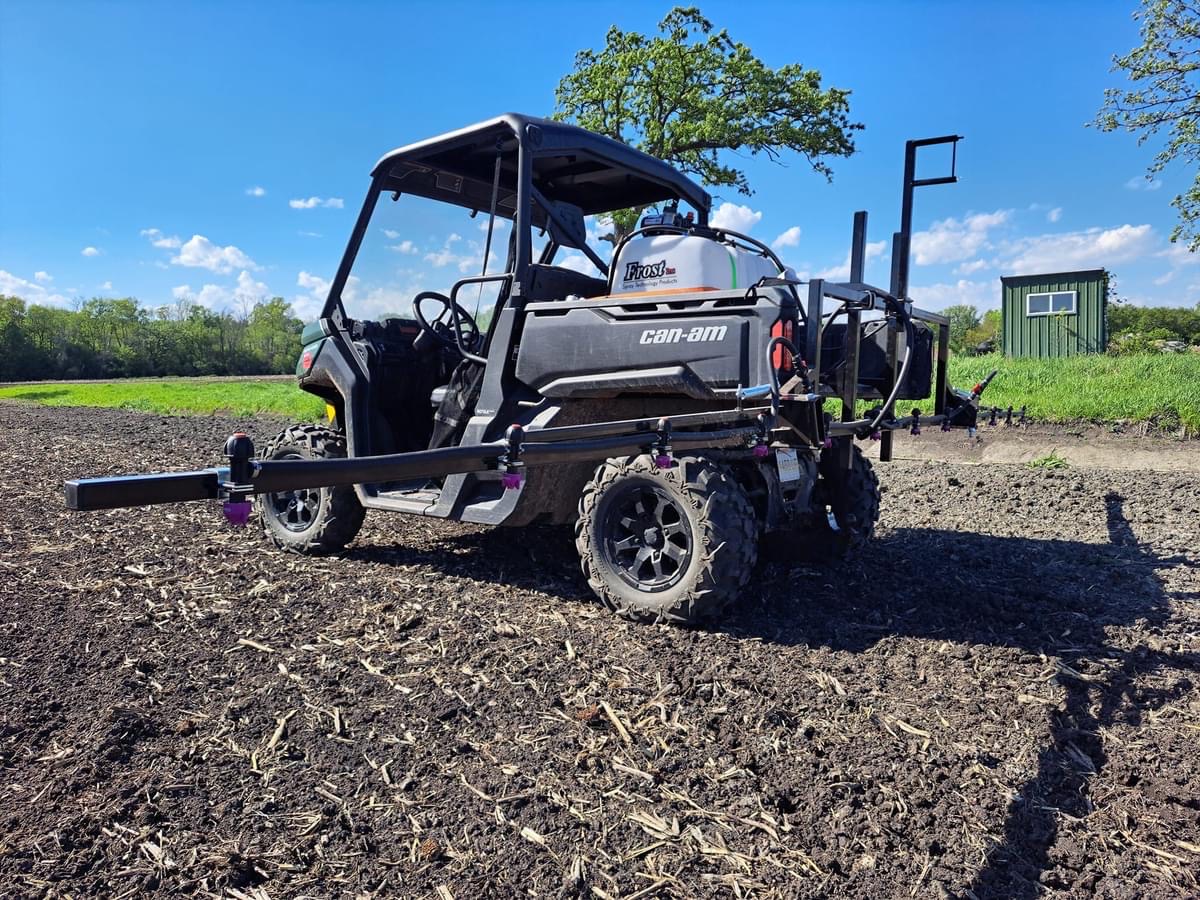
Timing is Critical!
On the weed or pest you are trying to control, you need to understand the lifecycle that they have. For example, to control thistles in a pasture, you need to spray before it blossoms and forms a seed head. Another example is Japanese Beetles. They should not be sprayed when you see them because the products to kill the beetle can also affect beneficial pollinators like bees and butterflies. Instead try to spray for the grubs earlier before they become beetles.
Sprayer Types:
- Manual Sprayers: Most of us start our spray career working with pump sprayers and backpack sprayers. They are very effective in pin-pointing areas that we want to focus on but are not effective for larger spaces.
- ATV sprayers: ATVs are very popular in the hunting industry and they are easily driven in rough areas. Simply attach a sprayer to the rack and drive your path.
- UTV sprayers: Side-by-Side’s are another popular vehicle that support a larger bed space and heavier carrying capacity.
- 3-Point Sprayers: People who are cultivating plot ground, typically have a tractor. The sprayer is just another attachment opportunity for an already effective machine.
- Trailer Sprayer: These are for larger acres and can be pulled behind a variety of tractors.
- Skid Loader Sprayers: More recently, people have been using skid loaders on their land and Frost Inc. has created a new quick-attach sprayer to make spraying simple.
Boom Types:
- Boomless Nozzle: A boomless nozzle is a maneuverable nozzle placed on either side of a short boom. Each nozzle can cover up to 13ft each. Or 30ft with the center nozzle and two boomless ends. This situation helps to spray through those areas that you cannot reach with a physical boom like rough ground, fence lines, or taller brush. Systemic herbicide products where one drop effects whole plant, are the best products used with a boomless nozzle boom.
- Broadcast Boom: A wider physical boom supports fan nozzles to spray directly towards the ground letting gravity help disperse spray to the target. Broadcast booms will also achieve a defined spray edge, so if you have an area that does not need the spray, these nozzles are less likely to spray into those unwanted areas. Contact chemical products which are effective based on contact, should always be sprayed with a broadcast boom.
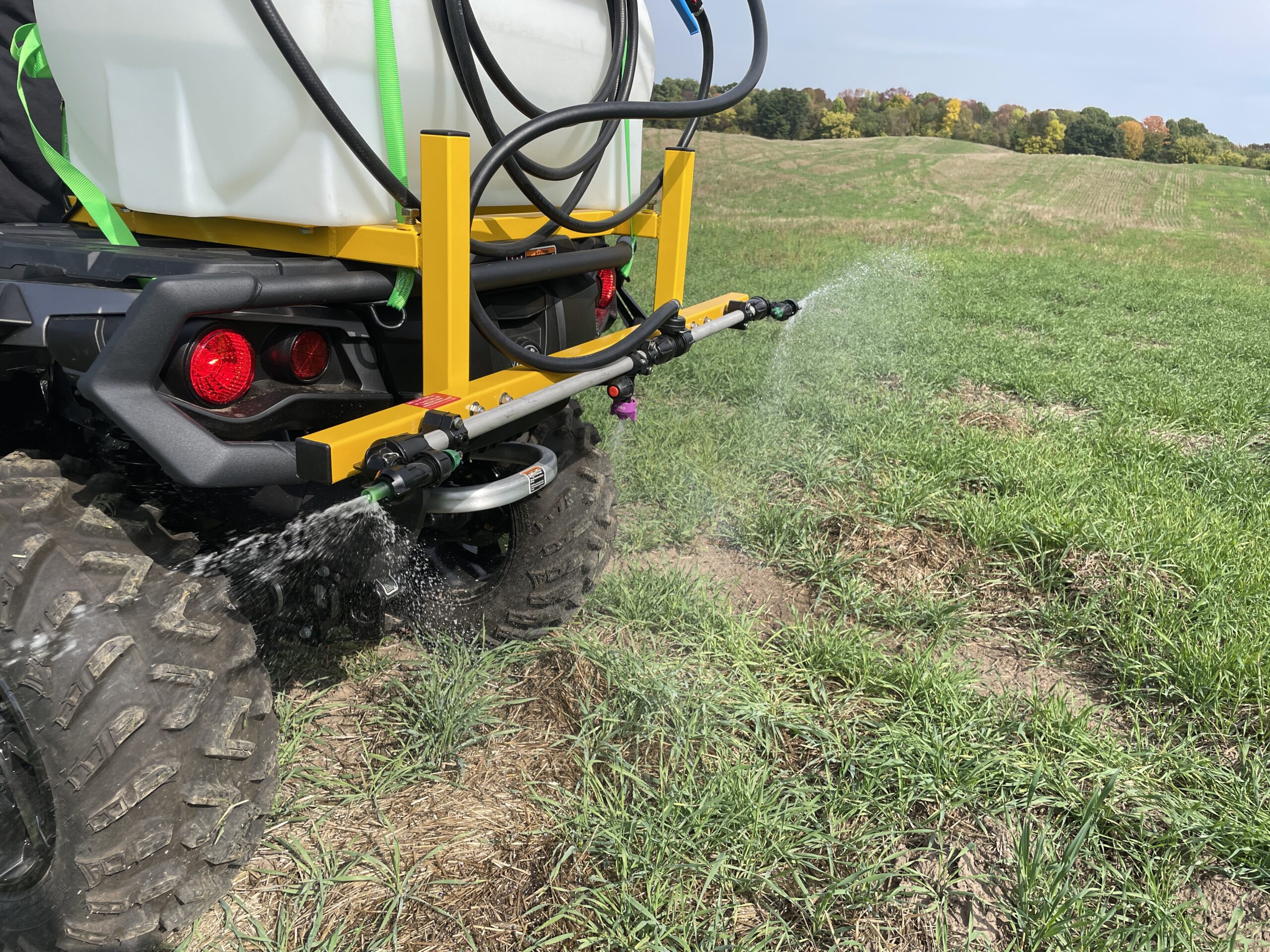
Main Sprayer Components:
- Tank: When looking at a sprayer, make sure to look at the tank. It may seem like an obvious vessel for liquids, but there are some important features to notice. For plastic tanks, choose a tank that is more heavy-duty with roto-molded material like a kayak. Avoid thinner blow-molded plastic material similar to a milk jug. Make sure to look for a sump at the bottom of the tank which is where all the product gathers, making it easier to completely empty the tank.
- Shut-off Valves: You always want to have a contingency plan in an emergency. Any penetration in the tank below the liquid level should have a shut off valve. That way if service is needed to any of the components, the liquid product can be safely contained.
- Agitation: If a spray product is not kept in a completely mixed state, inconsistencies in your spray jobs will result. Often a spray product will settle toward the bottom of the tank especially if it is left sitting for any extended period of time. Agitation or recirculation should be done before attempting to spray, to remix the product and ensure the best efficacy.
- Filter: It is important to check the filter screen condition before attempting to spray. This is one of the simplest yet most overlooked duties for beginners. Pumps, valves and nozzles all need to be protected from sand and debris that show up in spray tanks. Filter screens provide that protection, but they need to be checked on a regular basis. If a filter screen is getting full, it will reduce the pressure at the nozzle and cause insufficient spray patterns.
- Pressure Control Valves: Spray nozzles are calibrated based on speed and pressure. Pressure control valves help dial in a recommended pressure for the nozzles and speed chosen.
- Boom Section Valves: These are valves to control groups of nozzles usually on a larger broadcast spray boom. Some booms may have valves to control each individual nozzle as well.
- Spray Nozzles: Nozzles are the last component to touch your spray product before it hits your target, which makes them a pretty important component. Nozzles essentially create the distribution pattern and are responsible for the overall efficacy of your sprayer.
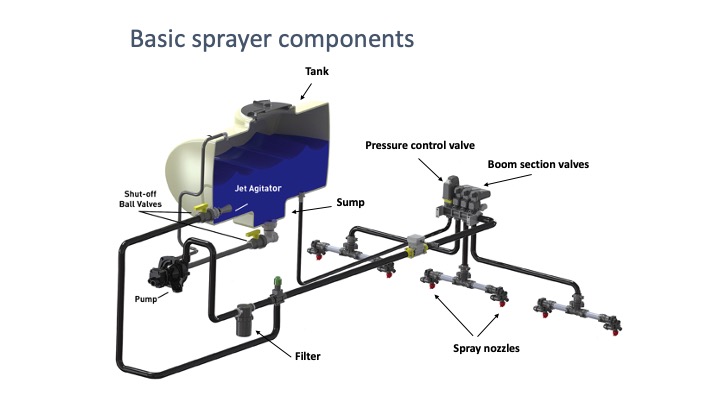
How to Choose Spray Nozzles:
When choosing a spray nozzle there are many things that can affect your choice for your sprayer. Spray nozzles started to be mass produced back in the ’50s and were machined out of brass for ease of machining. Over time, we learned that brass wears out very fast, especially with any abrasive spray products. Stainless steel then became a popular nozzle material but it too wears out over time. Polyacetal nozzles are what we use today, which is an engineered plastic that allows for molding new technologies for droplet size and drift control.
Calibration, Don’t Just Guess!
For manual sprayers, the question that needs to be answered is, “How many Gallons per acre does my sprayer put out?” When this question is answered, you will know how many ounces of concentrated product (from the label) to add to a gallon of water to spray.
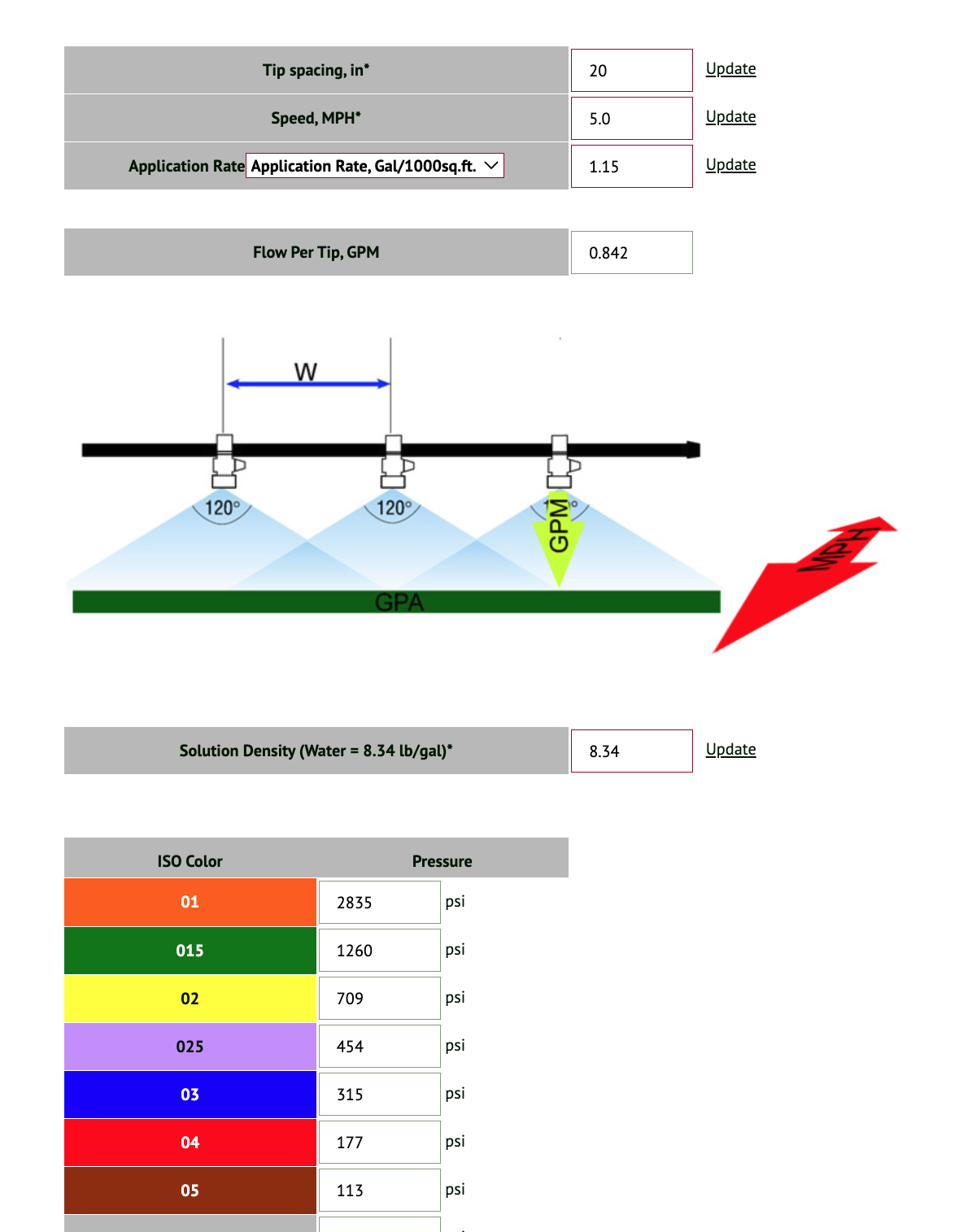
You can find the basic steps to calibrate a manual sprayer here.
For Boomless and Broadcast Sprayers, the question to be answered is, “What pressure should I spray at?”
Nozzles today are pre-calibrated and color-coded to ISO standards. The tools online will help find your correct pressure. Use a simple nozzle calculator online here.
Tips when using the online calculator: spacing is usually 20”, enter lowest speed and then again max speed, and the desired application rate in gallons per acre, or gallons per 1,000 sq ft. Results will show color coded nozzle choices with pressures listed. Whichever nozzle shows an operating pressure within the pressure range or your sprayer, is the one to use.
Other Helpful Technologies:
Fertilizer Drops: Fertilizer Drops apply liquid fertilizer to post emergent corn plants to deliver fertilizer more efficiently. Liquid fertilizer is placed alongside the plant within the root zone so the plant can start utilizing it right away and when the plant needs it most. Frost offers ‘Super-Drop’ attachments that connect to a boom structure down the middle of each row and connect to the liquid system of the sprayer. Find an application calculator for fertilizer drops here.

Tips when using the online calculator: Choose row spacing, desired speed, gallon per acre rate, and fertilizer density. You will then see which orifice to use and at what pressure. Dial-a-Rate devices are best used if you are changing rates and speeds often.
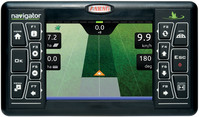 GPS Guidance: Plots that are not row-crop, or are not exactly square, can be hard to navigate and ensure even spray coverage. GPS guidance monitors can help by showing where you have sprayed and where you haven’t. They can also create gridlines with A & B-points to help you steer your sprayer and keep it on course. GPS guidance monitors replace foam marking systems and can be used for field work other than spraying.
GPS Guidance: Plots that are not row-crop, or are not exactly square, can be hard to navigate and ensure even spray coverage. GPS guidance monitors can help by showing where you have sprayed and where you haven’t. They can also create gridlines with A & B-points to help you steer your sprayer and keep it on course. GPS guidance monitors replace foam marking systems and can be used for field work other than spraying.
Application Verification: Another benefit of a GPS guidance monitor is the saving of job files in KML file format. KML files can be viewed in google Earth to show where a job was performed visually. This can be especially helpful to custom food plot managers to show evidence of their work.
Final Thoughts:
Make sure that you take care of your equipment after each use, especially in the Fall. Run RV antifreeze through it when you are done for the season. This will protect it from freeze damage and will also keep rubber parts lubricated and ready to use the next time you need it.
Check out FrostServ.com for more information and to choose the best sprayer for your plot!
